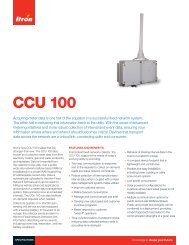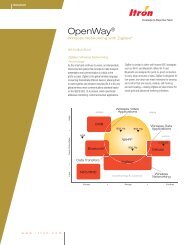Modeling and Accounting Methods for Estimating Unbilled ... - Itron
Modeling and Accounting Methods for Estimating Unbilled ... - Itron
Modeling and Accounting Methods for Estimating Unbilled ... - Itron
- No tags were found...
You also want an ePaper? Increase the reach of your titles
YUMPU automatically turns print PDFs into web optimized ePapers that Google loves.
<strong>Itron</strong> White PaperEnergy Forecasting<strong>Modeling</strong> <strong>and</strong><strong>Accounting</strong><strong>Methods</strong> <strong>for</strong><strong>Estimating</strong><strong>Unbilled</strong> EnergyJ. Stuart McMenamin, Ph.D.Vice President, <strong>Itron</strong> Forecasting© 2006, <strong>Itron</strong> Inc. All rights reserved. 1
<strong>Methods</strong> <strong>for</strong> <strong>Estimating</strong> the <strong>Unbilled</strong> CornerThere are two ways to compute the numerical value <strong>for</strong> the unbilled corner (C in Figure 1). The first involves direct estimation.We call this the Direct Approach. The second involves a recursive <strong>for</strong>mula in which the current month’s unbilled value dependson the prior month’s unbilled value. We call this the Prior-<strong>Unbilled</strong> Approach. As is shown below, with the Prior-<strong>Unbilled</strong>Approach, errors in the estimation of unbilled energy in one month will propagate to the following month. If there is a consistentbias in the method, this will result in a constantly growing drift in the unbilled estimate, which can result in serious problems,such as negative values <strong>for</strong> unbilled energy. The purpose of this paper is to demonstrate this fact <strong>and</strong> also to show the potentialimpacts of both approaches on income statements <strong>and</strong> balance sheets.Both approaches necessarily involve estimation. In the Direct Approach, we estimate calendar month sales <strong>and</strong> unbilled salesdirectly. This is typically based on models that account <strong>for</strong> the number of days in each period (weighted across cycles) <strong>and</strong> theweather that occurred over the days in each period. In modeling terms, we develop a model that has the number of days, weather,<strong>and</strong> other seasonal factors as inputs. The model is usually estimated with billing cycle days <strong>and</strong> billing cycle weather as theinputs. Once estimated, this model can be used to simulate energy use over other calendar periods.In terms of the geometry, models are estimated using data <strong>for</strong> the billing cycle parallelograms, A+B. The coefficients of theestimated models can then be used to estimate values using inputs <strong>for</strong> the calendar month (B+C) or <strong>for</strong> the unbilled corner (Calone). When the later is done, it is critical that the model works well on a per-day basis, since the number of days in the unbilledcorner (C) is likely to be about half of the number of days in the billing cycle.One way to approach the calculations is through the use of models to create ratios of the geometric areas. We call these ratios theBooked-To-Billed Ratio <strong>and</strong> the <strong>Unbilled</strong> Fraction.Booked-To-Billed RatioThe first ratio is the Booked-To-Billed (BTB) ratio, <strong>and</strong> it provides an estimate of calendar month energy (B+C) relative to billingcycle energy (A+B).ModelBTB =ModelModel=Model( Calendar Month Days,Calendar Month Weather )( Billing Cycle Days,Billing Cycle Weather)( B + C)( A + B)(1)The BTB ratio will be greater than 1.0 when the number of days in the calendar month is greater than the number of days in thebilling cycles <strong>and</strong>/or the weather in the calendar month is more extreme. Although the adjustment <strong>for</strong> days can be significant, theadjustment <strong>for</strong> weather is usually the determining factor <strong>for</strong> the weather sensitive customer classes. For example, in springmonths such as May, the calendar month weather is normally warmer than the billing cycle weather (which spans April <strong>and</strong>May). As a result, BTB ratios tend to be greater than one <strong>and</strong> can be as large as 1.5 in extreme cases in the spring <strong>and</strong> earlysummer months. On the flip side, fall BTB ratios can be significantly less than one. Especially <strong>for</strong> gas utilities, a similar dynamicoccurs going into winter with BTB ratios greater than one on the way into the winter <strong>and</strong> BTB ratios less than one coming out ofwinter.© 2006, <strong>Itron</strong> Inc. All rights reserved. 5
Example DataThe example starts with the following table, which presents a set of hypothetically true values. In the example, the current monthbilled energy is 200 GWh in aggregate across two classes. Half of the billed energy is from the prior month (A) <strong>and</strong> half of thebilled energy is in the current month (B). Energy use <strong>for</strong> the current month is a smaller value at 185 GWh. Calendar monthenergy use (B+C) is 90 (which is 10% below billed energy) <strong>for</strong> the first class <strong>and</strong> is 95 (which is 5% below billed energy) <strong>for</strong> thesecond class.Figure 2 Example DataFor the purposes of the example, assume that these values are correct, although billed energy (A+B) is the only quantity that isactually measured directly.Examples Using Prior-<strong>Unbilled</strong> ApproachFor the Prior-<strong>Unbilled</strong> Approach, the monthly process is as follows:• Prior month unbilled energy (A) is estimated at the beginning of the month.• Billed energy is measured during the month <strong>and</strong> is known at month’s end.• Booked energy (B+C) is estimated at the end of the month.• <strong>Unbilled</strong> energy <strong>for</strong> the current month (C) is estimated based on the above.• Revenue <strong>and</strong> unbilled accrual are computed <strong>for</strong> the current month.The order here is important. Prior month unbilled (A) is estimated be<strong>for</strong>e the monthly total (A+B) is known. It is held fixedregardless of the outcome <strong>for</strong> the sum (A+B). Balance sheet results <strong>and</strong> income statement results are then based on the dollarvalues <strong>for</strong> each of the volume outcomes. Dollar values <strong>for</strong> billed energy are computed directly from the bills. Dollar values <strong>for</strong>unbilled energy are estimated, usually based on average prices. The books are closed with the following entries:Revenue = Billed Sales based on (A+B)+ <strong>Unbilled</strong> Sales based on (C) (5)– Prior <strong>Unbilled</strong> Sales based on (A)Assets = Cash <strong>and</strong> Receivables based on Billed Sales (A+B) (6)+ <strong>Unbilled</strong> Accrual based on <strong>Unbilled</strong> Sales (C)The revenue calculation is most often stated as Revenue equals Billed Sales plus the change in the <strong>Unbilled</strong> Accrual. However,the explicit representation of the change in unbilled makes it clear that, from a revenue perspective, revenue from the prior© 2006, <strong>Itron</strong> Inc. All rights reserved. 7
unbilled accrual is effectively reversed when current month revenue is calculated. From a balance-sheet perspective, the priorunbilled accrual is replaced by the current month unbilled accrual.Prior-<strong>Unbilled</strong> Approach: Scenario 1This process is depicted in Figure 3. The process begins with the Prior <strong>Unbilled</strong> estimate in Column 1. At the end of the month,Billed energy is entered into column 2. Based on weather over the calendar month relative to the billing cycles, the BTB ratio iscomputed <strong>and</strong> entered in column 3. The BTB ratio is multiplied by billed energy to get the calendar month booked estimate,which is entered in column 4.The key step is in column 5. Here the current month unbilled is calculated as calendar month energy minus billed energy plusprior month unbilled. The idea here is that we have estimated calendar month energy (B+C), but to get the unbilled part (C) weneed to subtract out the already billed component (B). We know billed energy (A+B), so we will subtract that out, but that takesaway too much <strong>and</strong> we need to add the prior month unbilled (A) back in. This can be expressed as follows:C = Calendar month (B+C) – Billed (A+B) + Prior month unbilled (A) (7)Another way to look at this is that we know billed energy (A+B) <strong>and</strong> we have the prior month estimate <strong>for</strong> A. There<strong>for</strong>e thealready billed part of the current calendar month (B) can be calculated as the difference between measured bills (A+B) <strong>and</strong> theestimate of the prior month unbilled (A). This interpretation can be expressed as follows:C = Calendar month (B+C) – Already billed ((A + B) – A) (8)The numbers are the same under either interpretation.Figure 3 Prior-<strong>Unbilled</strong> Approach: Scenario 1The revenue numbers shown in the final column are presented in energy units (priced out at $1 per unit) <strong>for</strong> purposes ofexposition. The revenue calculation is:Revenue = Billed (A+B) – Prior <strong>Unbilled</strong> (A) + <strong>Unbilled</strong> (C) (9)This can be expressed in two alternative <strong>for</strong>ms:Revenue = Billed (A+B) + Change in <strong>Unbilled</strong> (C-A) (10)= Already billed (B) + <strong>Unbilled</strong> (C)8 © 2006, <strong>Itron</strong> Inc. All rights reserved.
Conceptually, the goal is expressed on the second line of expression (10). That is, current month revenue has two components,both of which must be estimated. The two components are the part that has already been billed <strong>and</strong> the unbilled accrual.The key point here is that the prior unbilled number drives the interpretation of current month results through the calculations incolumns 5, 6 <strong>and</strong> 7. This is seen in the following example which leaves all current month billed <strong>and</strong> booked values at their correctlevels, but introduces an error into the prior month unbilled values.Prior-<strong>Unbilled</strong> Approach: Scenario 2In this scenario, all numbers are the same as the prior example, except that Class 1 prior unbilled is reduced by 20 GWh <strong>and</strong>Class 2 prior unbilled is increased by 20 GWh. The idea is that these values are incorrect because of some error in computing theprior unbilled or because of a buildup of accumulated errors or biases from prior calculations.As seen in Figure 4, the prior month errors propagate directly through to the current month. For example, <strong>for</strong> Class 1, billedenergy is the same (100) <strong>and</strong> booked energy is the same (90) as in the first example. But because prior unbilled is 20 GWh toolow (at 30 instead of 50), the current month unbilled is also 20 GWh too low (at 20 instead of 40). The error in unbilled <strong>for</strong> theprior month passes directly through to an equal error in unbilled in the current month. Once introduced, this error will never goaway unless an offsetting correction is made.Figure 4 Prior <strong>Unbilled</strong> Approach: Scenario 2This error does no damage to the totals because it is assumed that an offsetting error is made to Class 2, which has unbilledoverestimated by 20. Also, since the prices <strong>for</strong> the two classes are equal ($1 per unit), there is no impact on total revenue.Prior-<strong>Unbilled</strong> Approach: Scenario 3In the final example, an error is introduced <strong>for</strong> Class 1 unbilled only. In this case, the idea is that biases in past calculationscaused an accumulated underestimate of unbilled energy in prior periods. This bias has accumulated over time to the point wherethe prior month unbilled is only 10 out of the billing total of 100. This implies that the difference of 90 is energy usage in thecurrent month, which shows in the Already Billed column. But the current month booked energy estimate is only 90 units,implying a current month unbilled estimate of 0. This occurs despite the fact that all current month totals (billed <strong>and</strong> booked) areexactly correct.© 2006, <strong>Itron</strong> Inc. All rights reserved. 9
Figure 5 Prior-<strong>Unbilled</strong> Approach: Scenario 3Although the revenue number <strong>for</strong> the month is not impacted in this scenario, the balance sheet will clearly have an ongoing bias,since the unbilled accrual is understated (45 instead of the true value of 85). This bias will continue until an accountingadjustment is made by increasing the unbilled accrual to a reasonable value in some month.Examples Using Direct ApproachFor the Direct Approach, the monthly process is as follows:• Billed energy is measured during the month <strong>and</strong> is known at month’s end.• Booked energy (B+C) is estimated at the end of the month.• <strong>Unbilled</strong> energy (C) is estimated at the end of the month.• Revenue <strong>and</strong> unbilled accrual are computed <strong>for</strong> the current month.The difference here is that these calculations are all made without reference to the prior month unbilled result. As will be shown,this implies an implicit correction to the prior month unbilled based on the billed results (A+B). It is this implicit correction thatbreaks the momentum <strong>and</strong> keeps calculation errors in one month from propagating to the following month.The calculation of Revenue <strong>and</strong> the <strong>Unbilled</strong> Accrual are the same as in the Prior-<strong>Unbilled</strong> method. That is:Revenue = Billed Sales based on (A+B) + Change in <strong>Unbilled</strong>Assets = Cash <strong>and</strong> Receivables based on Billed Sales (A+B) (11)+ <strong>Unbilled</strong> Accrual based on <strong>Unbilled</strong> Sales (C)Although these calculations take the same <strong>for</strong>m, as shown below, the ingredients are slightly different.Direct Approach: Scenario 1The Direct method with correct inputs is depicted in Figure 6. The process begins with the Billed Sales data in column 2.Application of the BTB ratio translated Billed Sales into estimated calendar month sales, presented in column 4. The unbilledfraction is then applied to the calendar month estimate to get <strong>Unbilled</strong> Sales, presented in column 6. Columns 7 <strong>and</strong> 8 showadditional results that are implied by these calculations.Column 7 shows the estimate of energy that is Already Billed <strong>for</strong> the current month. In the example <strong>for</strong> Class 1, sales <strong>for</strong> thecalendar month are estimated to be 90 <strong>and</strong> the unbilled fraction (44.4%) implies unbilled sales of 40. This implies that theremaining 50 are in the Already Billed triangle (B).10 © 2006, <strong>Itron</strong> Inc. All rights reserved.
The numbers below the expression provide values from the numerical example <strong>for</strong> each term in the expression. Expression 13rein<strong>for</strong>ces what we saw in the example. With the Direct approach, booked revenue will not equal revenue from calendar monthoperations. It will equal calendar month revenue plus the implicit correction to prior month unbilled. It is not necessary to statethis as an accounting correction. All that needs to happen is the following:-- Estimate Calendar Month based on Billed <strong>and</strong> the BTB ratio-- Estimate <strong>Unbilled</strong> based on Calendar Month <strong>and</strong> the <strong>Unbilled</strong> Fraction-- Report Revenue as Billed plus Change in <strong>Unbilled</strong>.The point of expression 13 is that the correction to the prior month unbilled is implicit in the revenue calculation. If the implicitcorrection is positive (prior unbilled was understated) then booked revenue will exceed revenue from calendar month operations.If the implicit correction is negative, then booked revenue will be less than revenue from calendar month operations.The key advantage of the direct approach is that it limits cumulative errors to the error in the estimation of the unbilled accrual inthe most recent month. And if the modeling is done in a reasonable way, this error is strictly bounded by the number of days <strong>and</strong>weather in the current unbilled corner relative to the number of days <strong>and</strong> weather over the most recent billing cycle.Volume Calibration to Zone SalesNote that the above conclusions are independent of whether calendar month volume estimates are calibrated to zone sales.Calibration can be treated as a minor variation in the calculation of the Booked-To-Billed multipliers. With calibration, themultipliers are adjusted upward or downward to make the calendar month sales estimates tie out to zone sales <strong>for</strong> that month lesslosses. Assuming that losses are accurately estimated <strong>and</strong> relatively stable, this provides calendar month <strong>and</strong> unbilled estimatesthat are calibrated to a measured control total <strong>for</strong> the month.© 2006, <strong>Itron</strong> Inc. All rights reserved. 15
<strong>Itron</strong> Inc.<strong>Itron</strong> is a leading technology provider <strong>and</strong> critical source of knowledge to the global energy <strong>and</strong> water industries. Nearly 3,000utilities worldwide rely on <strong>Itron</strong> technology to deliver the knowledge they require to optimize the delivery <strong>and</strong> use of energy <strong>and</strong>water. <strong>Itron</strong> delivers value to its clients by providing industry-leading solutions <strong>for</strong> electricity metering; meter data collection;energy in<strong>for</strong>mation management; dem<strong>and</strong> response; load <strong>for</strong>ecasting, analysis <strong>and</strong> consulting services; distribution system design<strong>and</strong> optimization; web-based work<strong>for</strong>ce automation; <strong>and</strong> enterprise <strong>and</strong> residential energy management.To know more, start here: www.itron.com<strong>Itron</strong> Inc.Corporate Headquarters2111 North Molter RoadLiberty Lake, Washington 99019U.S.A.Tel.: 1.800.635.5461Fax: 1.509.891.3355<strong>Itron</strong> Inc.Energy Forecasting - West11236 El Camino RealSan Diego, Cali<strong>for</strong>nia 92130-2650Phone: 1.858-724-2620Toll Free: 1.800.755.9585Fax: 1.858.724.2690Email: <strong>for</strong>ecasting@itron.comwww.itron.comwww.itron.com/<strong>for</strong>ecastingDue to continuous research, product improvement <strong>and</strong> enhancements, <strong>Itron</strong> reserves the right to change product or system specifications without notice. <strong>Itron</strong> is a registered trademarkof <strong>Itron</strong> Inc. All other trademarks belong to their respective owners. © 2006, <strong>Itron</strong> Inc.Publication 100650WP-0212/06
















